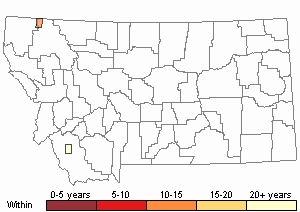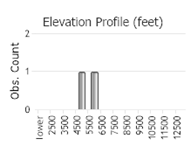View in other NatureServe Network Field Guides
NatureServe
Montana
Utah
Wyoming
Idaho
Wisconsin
British Columbia
South Carolina
Yukon
California
New York
A Diatom - Stauroneis obtusa
General Description
Morphological Category – Symmetric biraphid.
Valves elliptic-lanceolate with bluntly rounded, unprotracted apices. Pseudosepta apparently absent from the apices.
Axial Area narrow, about twice the width of the raphe.
Central Stauros shaped like a bow tie.
Raphe thread-like. Proximal raphe ends almost straight and tipped with small pores. Distal raphe ends curved to one side.
Striae radiate throughout.
Areolae very fine, about 30 in 10 µm.
Size RangeLength 20-27 µm.
Width 5-7 µm.
Striae in 10 µm 22-24.
Useful Link:
Diatom Glossary [Diatoms of North America website]
Diagnostic Characteristics
Stauroneis obtusa is much smaller than Stauroneis subhyperborea and Stauroneis clarkia. Stauroneis obtusa lacks the subrostrate apices of S. lewisii.
Range Comments
Recorded from the Rocky Mountains in Montana and the Cascade Mountains in Washington and California.
Observations in Montana Natural Heritage Program Database
Number of Observations: 2
(Click on the following maps and charts to see full sized version)
Map Help and Descriptions
Relative Density

Recency



 (Observations spanning multiple months or years are excluded from time charts)
(Observations spanning multiple months or years are excluded from time charts)
Habitat
Mountain lakes and streams.
Ecology
Cold, circumneutral waters with low nutrients and conductivity.
Reproductive Characteristics
Diatoms typically reproduce by cell division (mitosis) and occasionally by meiosis—sexual reproduction in which female and male gametes combine to form a specialized zygote called an auxospore. Repeated divisions result in cells of a population becoming progressively smaller and smaller. When cells reach a critically small size, sexual reproduction is initiated, resulting in an auxospore and initial cells that are the largest attainable for the species, after which cell division and size reduction resume (Amato 2010).
Stewardship Responsibility
Threats or Limiting Factors
Climate change and regional warming.
References
- Literature Cited AboveLegend:
 View Online Publication
View Online Publication Amato, A. 2010. Diatom reproductive biology: living in a crystal cage. The International Journal of Plant Reproductive Biology 2(1): 1-10.
Amato, A. 2010. Diatom reproductive biology: living in a crystal cage. The International Journal of Plant Reproductive Biology 2(1): 1-10.
- Additional ReferencesLegend:
 View Online Publication
View Online Publication
Do you know of a citation we're missing? Bahls, L. 2012. Five new species of Stauroneis (Bacillariophyta, Stauroneidaceae) from the northern Rocky Mountains, USA. Phytotaxa 67: 1-8.
Bahls, L. 2012. Five new species of Stauroneis (Bacillariophyta, Stauroneidaceae) from the northern Rocky Mountains, USA. Phytotaxa 67: 1-8. Bahls, Loren. 2010. Stauroneis in the Northern Rockies: 50 species of Stauroneis sensu stricto from western Montana, northern Idaho, northeastern Washington and southwestern Alberta, including 16 species described as new. Northwest Diatoms, Volume 4. The Montana Diatom Collection, Helena, 172 pp.
Bahls, Loren. 2010. Stauroneis in the Northern Rockies: 50 species of Stauroneis sensu stricto from western Montana, northern Idaho, northeastern Washington and southwestern Alberta, including 16 species described as new. Northwest Diatoms, Volume 4. The Montana Diatom Collection, Helena, 172 pp. Bahls, Loren. 2021. Diatoms of Montana and western North America: Catalog and atlas of species in the Montana diatom collection Volume 1. The Academy of Natural Sciences of Philadelphia Special Publication 24. 508pp.
Bahls, Loren. 2021. Diatoms of Montana and western North America: Catalog and atlas of species in the Montana diatom collection Volume 1. The Academy of Natural Sciences of Philadelphia Special Publication 24. 508pp. Lagerstedt, N.G.W. 1873. Sötvatens-Diatomaceer fran Spetsbergen och Beeren Eiland. Bihang till Kongliga Svenska Vetenskaps-Akademiens Handlingar 1(14): 1-52.
Lagerstedt, N.G.W. 1873. Sötvatens-Diatomaceer fran Spetsbergen och Beeren Eiland. Bihang till Kongliga Svenska Vetenskaps-Akademiens Handlingar 1(14): 1-52. Van de Vijver, B., Beyens, L. and Lange-Bertalot, H. 2004. The genus Stauroneis in Arctic and Antarctic Regions. Bibliotheca Diatomologica 50, 312 pp.
Van de Vijver, B., Beyens, L. and Lange-Bertalot, H. 2004. The genus Stauroneis in Arctic and Antarctic Regions. Bibliotheca Diatomologica 50, 312 pp.
- Web Search Engines for Articles on "A Diatom"





